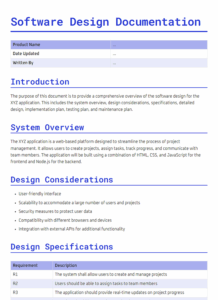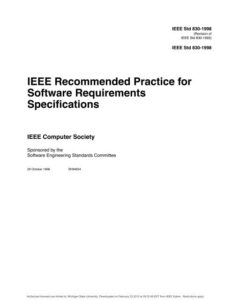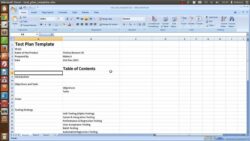Ever feel like you’re building a house without blueprints? That’s kind of what it’s like developing a product or a piece of software without proper technical specifications. It’s chaotic, confusing, and often leads to a final product that’s… well, not quite what you envisioned. A clear and comprehensive technical specification documentation template can be the difference between a successful launch and a frustrating failure. It’s your guide, your contract, and your single source of truth throughout the entire development lifecycle.

Think of a technical specification documentation template as a detailed recipe. It outlines every ingredient (component), every step (process), and the exact measurements (parameters) needed to create a delicious dish (functional product). Without it, you’re left guessing, improvising, and hoping for the best. While a little culinary experimentation can be fun, it’s rarely the recipe for a reliable and scalable product.
This article will walk you through the importance of using a technical specification documentation template, its core components, and how to create one that’s actually useful for your team. We’ll explore best practices, common pitfalls, and how to ensure your documentation stays relevant and up-to-date. So, let’s ditch the guesswork and start building with confidence!
Why a Robust Technical Specification is Your Best Friend
A solid technical specification is far more than just a nice-to-have document; it’s the backbone of any successful technical project. It serves as a shared understanding among developers, designers, project managers, and even stakeholders. Imagine trying to explain the complexities of a new software feature verbally to a dozen different people. Chances are, you’ll get a dozen different interpretations. A clear, well-written specification eliminates ambiguity and ensures everyone is on the same page.
Moreover, a technical specification acts as a critical communication tool throughout the development process. It clearly defines the “what” and the “how” of the product, ensuring that everyone involved understands the requirements, functionalities, and design choices. This collaborative approach can significantly reduce misunderstandings, rework, and ultimately, project costs. A well-crafted specification also helps in identifying potential problems early on, allowing the team to address them proactively before they escalate into major roadblocks.
Beyond its role in development, a technical specification provides invaluable documentation for future maintenance and upgrades. When it comes time to add new features, fix bugs, or even completely overhaul the system, the specification serves as a roadmap, guiding developers through the existing codebase and ensuring that any changes are made in a consistent and well-documented manner. This is especially crucial for long-term projects or when new developers join the team who may not be familiar with the original design.
Furthermore, consider the legal and contractual aspects. A technical specification can serve as a reference point in disputes with clients or vendors. It provides a clear record of what was agreed upon and what was delivered, minimizing the risk of misunderstandings and disagreements. This is particularly important in outsourced projects where communication can be challenging and misunderstandings can easily arise.
Think of the technical specification documentation template as an investment. Spending the time and effort to create a detailed and accurate specification upfront will save you countless hours of frustration, rework, and cost overruns down the line. It’s a foundational element that sets the stage for a successful and efficient development process.
Key Elements of an Effective Technical Specification Documentation Template
So, what exactly goes into a killer technical specification documentation template? While the specific content will vary depending on the nature of your project, certain core elements are essential for ensuring clarity, completeness, and usability. First and foremost, you need a clear and concise introduction that outlines the purpose, scope, and objectives of the document. This section should provide a high-level overview of the product or feature being described, setting the stage for the more detailed information that follows.
Next, you’ll want to define the overall system architecture. This involves describing the major components of the system, how they interact with each other, and any relevant interfaces. A diagram or visual representation can be incredibly helpful in illustrating the architecture and making it easier to understand. This section should also include information about the technology stack being used, such as programming languages, databases, and frameworks.
A crucial component is a detailed description of the functional requirements. This section outlines what the system is supposed to do, including all the inputs, outputs, and processing logic involved. Use cases, user stories, and flowcharts can be valuable tools for capturing and documenting these requirements in a clear and concise manner. Be sure to include specific examples and scenarios to illustrate how the system should behave under different conditions.
Don’t forget the non-functional requirements, such as performance, security, scalability, and usability. These requirements are just as important as the functional ones, as they directly impact the overall user experience and the system’s ability to meet business needs. Define specific metrics and targets for each non-functional requirement, and explain how you will measure and verify that these targets are being met.
Finally, include sections for error handling, data management, and security considerations. Describe how the system will handle errors and exceptions, how data will be stored and managed, and what security measures will be implemented to protect sensitive information. By addressing these important aspects early on, you can prevent potential problems and ensure that the system is robust, reliable, and secure. Remember that a well-structured technical specification documentation template is a living document that evolves over time as the project progresses, so be sure to keep it up-to-date and accurate throughout the entire development lifecycle.
Creating a high-quality technical specification doesn’t need to be a daunting task. With a solid understanding of the essential elements and a commitment to clear and concise communication, you can create documentation that empowers your team, reduces risks, and ultimately, leads to a more successful project.
By investing in a great technical specification documentation template, you not only clarify the project but also pave the way for smoother collaboration, reduced errors, and a final product that truly meets expectations.



